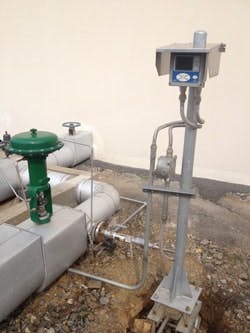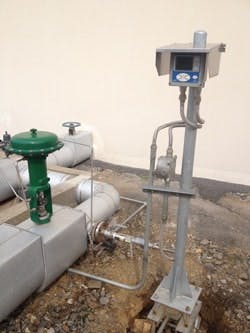Conductivity Measurement Optimizes Naphtha Tank Draining
The valuable role that conductivity measurement can play often is under-appreciated. For instance, conductivity is an excellent way to detect the interface between a non-conductive liquid such as a hydrocarbon and a conductive aqueous solution. Such measurements can enable significant saving of time and money, as Hanwha Total Petrochemical, Seoul, South Korea, found out.
Hanwha Total operates a large petrochemical complex consisting of 13 separate plants at Daesan, in South Korea’s Chungnam Province. There, the company manufactures building-block chemicals used for making of a host of other chemicals needed for various consumer products. Processing at Daesan starts with a naphtha cracker, yielding propylene and ethylene, which are the raw materials for producing many polymers.
The naphtha feed for the cracker is kept in storage tanks. During storage, water accumulates and sinks to the bottom of the tank because it has a greater specific gravity than naphtha. This water would interfere with the cracking process and so requires periodic draining to prevent it from flowing into the cracker. During tank draining, it is necessary to monitor for any hydrocarbon leakage into the drain sump located at the tank area. Such leakage may mandate additional treatment of the drained water so it complies with environmental regulations for discharge and also represents a loss of naphtha.
Traditionally, Hanwha Total assigned an operator to manually perform tank draining on a quarterly basis. In the draining mode, the water passes through a special pipe assembly with a glass section. The operator, upon seeing the oil start to flow through that glass section, informs the control room to close the drain valve.
Figure 1. Loop-powered analyzer and conductivity sensor enable efficient removal of water from tank with minimal loss of naphtha.
This is a very tedious task for the operator because tank draining is a lengthy process (taking approximately 2–3 hours) that requires the operator’s presence during the entire operation. Also, visually determining the point at which oil, not water, begins to drain is not easy. Hence, there is a danger the drain valve will be closed too late, resulting in hydrocarbons flowing into the sump. This increases the load on the downstream water-treatment facility and, thus, water treatment costs and also wastes costly hydrocarbon raw material.
Conductivity is ideal for monitoring the drain. The water has a conductivity between 650 and 1,000 μS/cm while the naphtha has essentially no conductivity. As the water drains the conductivity is high, but when the naphtha interface is reached the conductivity falls. Thus, using an interlock system to close the valve at the first sign of a conductivity drop can ensure that draining incurs a minimum loss of naphtha.
In May 2016, Hanwha Total installed a Rosemount 1066 loop-powered liquid analyzer and 402 conductivity sensor (Figure 1) in 12 tanks. If the conductivity level passes a set threshold, the sensor alerts an operator in the control room and the system automatically closes the drain valve. The simple addition of the analyzer and sensors has substantially reduced time demands on the plant’s staff and, even more significantly, has dramatically decreased leakage of costly naphtha from the tanks.
Using conductivity measurements coupled to an online interlock system has provided Hanwha Total with several key benefits:
• Draining now takes considerably less time.
• Control is real-time and better while affording significant savings over the prior labor-intensive approach.
• Eliminating additional water-treatment work allows operators to focus on other equipment.
• Minimizing naphtha contamination of the water eases compliance with environmental regulations, avoiding potential fines while giving plant management peace of mind in knowing that wastewater meets regulatory requirements.
In addition, the retractable mounting assembly of the 402 conductivity sensor yields further savings because it enables doing maintenance work on the sensor without interrupting the process.
Conductivity analysis is one of the most commonly used liquid measurements — for good reason. As this installation exemplifies, adding conductivity instrumentation can significantly improve process efficiency, quality and reliability.
LEE JU YOUNG is a senior account manager for Emerson Automation Solutions in Seoul, South Korea. Email him at [email protected].

